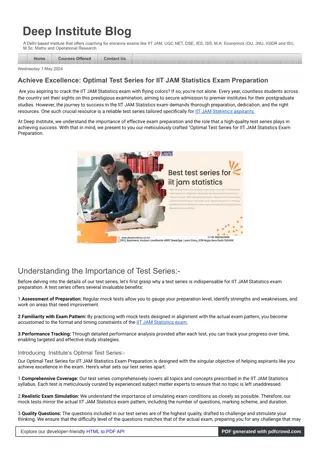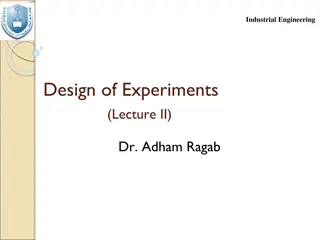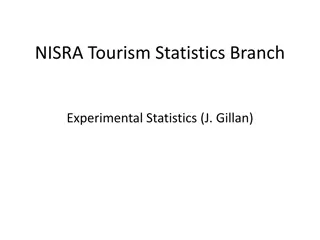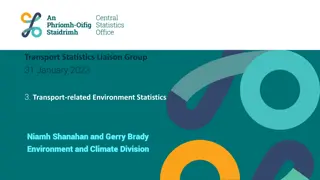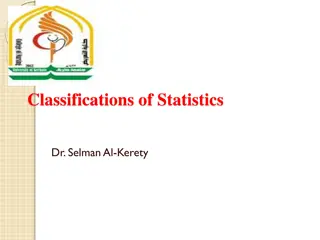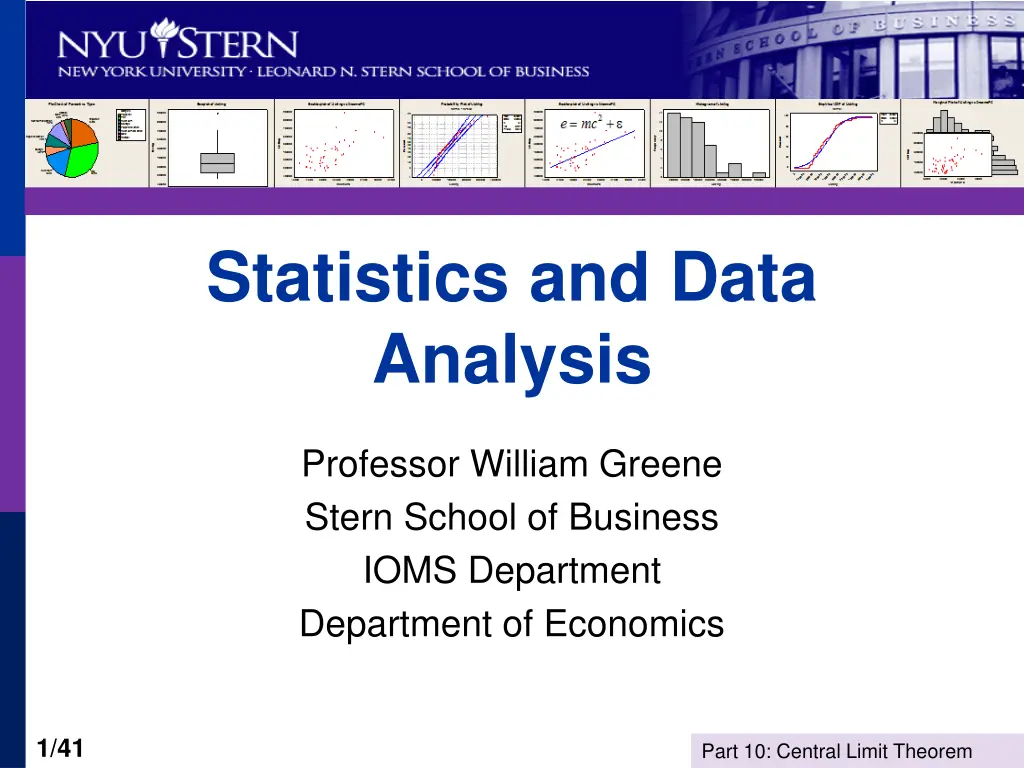
Understanding Central Limit Theorem in Statistics and Data Analysis
Explore the principles of statistical inference, random sampling, and the Central Limit Theorem in this comprehensive guide by Professor William Greene. Learn about sample means, population characteristics, random sampling, and more. Dive into the world of statistical analysis and inference to draw meaningful conclusions from data.
Download Presentation

Please find below an Image/Link to download the presentation.
The content on the website is provided AS IS for your information and personal use only. It may not be sold, licensed, or shared on other websites without obtaining consent from the author. If you encounter any issues during the download, it is possible that the publisher has removed the file from their server.
You are allowed to download the files provided on this website for personal or commercial use, subject to the condition that they are used lawfully. All files are the property of their respective owners.
The content on the website is provided AS IS for your information and personal use only. It may not be sold, licensed, or shared on other websites without obtaining consent from the author.
E N D
Presentation Transcript
Statistics and Data Analysis Professor William Greene Stern School of Business IOMS Department Department of Economics 1/41 Part 10: Central Limit Theorem
Statistics and Data Analysis Part 10 The Law of Large Numbers and the Central Limit Theorem 2/41 Part 10: Central Limit Theorem
Sample Means and the Central Limit Theorem Statistical Inference: Drawing Conclusions from Data Sampling Random sampling Biases in sampling Sampling from a particular distribution Sample statistics Sampling distributions Distribution of the mean More general results on sampling distributions Results for sampling and sample statistics The Law of Large Numbers The Central Limit Theorem 3/41 Part 10: Central Limit Theorem
Overriding Principles in Statistical Inference Characteristics of a random sample will mimic (resemble) those of the population Mean, Median, etc. Histogram The sample is not a perfect picture of the population. It gets better as the sample gets larger. (We will develop what we mean by better. ) 4/41 Part 10: Central Limit Theorem
Population The set of all possible observations that could be drawn in a sample Random Sampling What makes a sample a random sample? Independent observations Same underlying process generates each observation made 5/41 Part 10: Central Limit Theorem
Representative Opinion Polling and Random Sampling 6/41 Part 10: Central Limit Theorem
Selection on Observables Using Propensity Scores This DOES NOT solve the problem of participation bias. 7/41 Part 10: Central Limit Theorem
Sampling From a Specified Population X1 X2 XN will denote a random sample. They are N random variables with the same distribution. x1, x2 xN are the values taken by the random sample. Xi is the ith random variable xi is the ith observation 8/41 Part 10: Central Limit Theorem
Sampling from a Poisson Population Operators clear all calls that reach them. The number of calls that arrive at an operator s station are Poisson distributed with a mean of 800 per day. These are the assumptions that define the population 60 operators (stations) are observed on a given day. x1,x2, ,x60 = 797 794 817 813 817 793 762 719 804 811 837 804 790 796 807 801 805 811 835 787 800 771 794 805 797 724 820 601 817 801 798 797 788 802 792 779 803 807 789 787 794 792 786 808 808 844 790 763 784 739 805 817 804 807 800 785 796 789 842 829 This is a (random) sample of N = 60 observations from a Poisson process (population) with mean 800. Tomorrow, a different sample will be drawn. 9/41 Part 10: Central Limit Theorem
Sample from a Normal Population The population: The amount of cash demanded in a bank each day is normally distributed with mean $10M (million) and standard deviation $3.5M. Random variables: X1,X2, ,XN will equal the amount of cash demanded on a set of N days when they are observed. Observed sample: x1 ($12.178M), x2($9.343M), , xN ($16.237M) are the values on N days after they are observed. X1, ,XN are a random sample from a normal population with mean $10M and standard deviation $3.5M. 10/41 Part 10: Central Limit Theorem
Sample from a Bernoulli Population The population is Likely Voters in New Hampshire in the time frame 7/22 to 7/30, 2015 X = their vote, X = 1 if Clinton X = 0 if Trump The population proportion of voters who would vote for Clinton is . The 652 observations, X1, ,X652 are a random sample from a Bernoulli population with mean . Aug.6, 2015. http://www.realclearpolitics.com/epolls/2016/president/nh/new_hampshire_trump_vs_clinton-5596.html 11/41 Part 10: Central Limit Theorem
Sample Statistics Statistic = a quantity that is computed from a random sample. = = x (1/N) = s [1/(N 1)] N Total x Ex. Sample sum: Ex. Sample mean i = i 1 N x i N = i 1 2 2 (x x) Ex. Sample variance i = i 1 Ex. Sample minimum x[1]. Ex. Proportion of observations less than 10 Ex. Median = the value M for which 50% of the observations are less than M. 12/41 Part 10: Central Limit Theorem
Sampling Distribution The sample itself is random, since each member is random. (A second sample will differ randomly from the first one.) Statistics computed from random samples will vary as well. 13/41 Part 10: Central Limit Theorem
A Sample of Samples Monthly credit card expenses are normally distributed with a mean of 500 and standard deviation of 100. We examine the pattern of expenses in 10 consecutive months by sampling 20 observations each month. 10 samples of 20 observations from normal with mean 500 and standard deviation 100; Normal[500,1002]. Note the samples vary from one to the next (of course). 14/41 Part 10: Central Limit Theorem
Variation of the Sample Mean Implication: The sample sum and sample mean are random variables. Any random sample produces a different sum and mean. When the analyst reports a mean as an estimate of something in the population, it must be understood that the value depends on the particular sample, and a different sample would produce a different value of the same mean. How do we quantify that fact and build it into the results that we report? 15/41 Part 10: Central Limit Theorem
Sampling Distributions The distribution of a statistic in repeated sampling is thesampling distribution. The sampling distribution is the theoretical population that generates sample statistics. 16/41 Part 10: Central Limit Theorem
The Sample Sum Expected value of the sum: E[X1+X2+ +XN] = E[X1]+E[X2]+ +E[XN] = N Variance of the sum. Because of independence, Var[X1+X2+ +XN] = Var[X1]+ +Var[XN] = N 2 Standard deviation of the sum = times N 17/41 Part 10: Central Limit Theorem
The Sample Mean Note Var[(1/N)Xi] = (1/N2)Var[Xi] (product rule) Expected value of the sample mean E(1/N)[X1+X2+ +XN] = (1/N){E[X1]+E[X2]+ +E[XN]} = (1/N)N = Variance of the sample mean Var(1/N)[X1+X2+ +XN] = (1/N2){Var[X1]+ +Var[XN]} = N 2/N2 = 2/N Standard deviation of the sample mean = / N 18/41 Part 10: Central Limit Theorem
Sample Results vs. Population Values The average of the 10 means is 495.87 The true mean is 500 The standard deviation of the 10 means is 16.72 . Sigma/sqr(N) is 100/sqr(20) = 22.361 The standard deviation of the sample of means is much smaller than the standard deviation of the population. 19/41 Part 10: Central Limit Theorem
Sampling Distribution Experiment 1,000 samples of 20 from N[500,1002] The sample mean has an expected value and a sampling variance. The sample mean also has a probability distribution. Looks like a normal distribution. This is a histogram for 1,000 means of samples of 20 observations from Normal[500,1002]. 20/41 Part 10: Central Limit Theorem
The Distribution of the Mean Note the resemblance of the histogram to a normal distribution. In random sampling from a normal population with mean and variance 2, the sample mean will also have a normal distribution with mean and variance 2/N. Does this work for other distributions, such as Poisson and Binomial? Yes. The mean is approximately normally distributed. 21/41 Part 10: Central Limit Theorem
Implication 1 of the Sampling Results x = E This means that in a random sampling situation, for any estimation error = ( - ), the mean is as likely to estimate too high as too low. (Roughly) The sample mean is " Note that this resu lt does not depend on the sample size. x ." unbiased 22/41 Part 10: Central Limit Theorem
Implication 2 of the Sampling Result The standard deviation of x is SD(x) = / N This is called the standard erro r of the m ean . Notice that the standard error is divided by N. The standard error gets smaller as N get larger, and goes to 0 as N This property is called If N is really huge, my estimator is (al s . . consistency most) perfect. 23/41 Part 10: Central Limit Theorem
The % is a mean of Bernoulli variables, Xi = 1 if the respondent favors the candidate, 0 if not. The % equals 100[(1/652) ixi]. (1) Why do they tell you N=652? (2) What do they mean by MoE = 3.8? (Can you show how they computed it?) Fundamental polling result: Standard error = SE = sqr[p(1-p)/N] MOE = 1.96 SE Aug.6, 2015. http://www.realclearpolitics.com/epolls/2016/president/nh/new_hampshire_trump_vs_clinton-5596.html 24/41 Part 10: Central Limit Theorem
Two Major Theorems Law of Large Numbers: As the sample size gets larger, sample statistics get ever closer to the population characteristics Central Limit Theorem: Sample statistics computed from means (such as the means, themselves) are approximately normally distributed, regardless of the parent distribution. 25/41 Part 10: Central Limit Theorem
The Law of Large Numbers x estimates . The estimation error is x The theorem states that the estimation error will get smaller as N gets larger. As N gets huge, the estimation error will go to zero. Formal as N , P[| x- | > ] regardless of how small is. The error in estimation goes away as N increases. . ly, 0 26/41 Part 10: Central Limit Theorem
The LLN at Work Roulette Wheel Proportion of Times 2,4,6,8,10 Occurs .5 .4 .3 P1I .2 .1 .0 0 100 200 300 400 500 I Computer simulation of a roulette wheel = 5/38 = 0.1316 P = the proportion of times (2,4,6,8,10) occurred. 27/41 Part 10: Central Limit Theorem
Application of the LLN The casino business is nothing more than a huge application of the law of large numbers. The insurance business is close to this as well. 28/41 Part 10: Central Limit Theorem
Insurance Industry and the LLN Insurance is a complicated business. One simple theorem drives the entire industry Insurance is sold to the N members of a pool of purchasers, any one of which may experience the adverse event being insured against. P = premium = the price of the insurance against the adverse event F = payout = the amount that is paid if the adverse event occurs = the probability that a member of the pool will experience the adverse event. The expected profit to the insurance company is N[P - F] Theory about and P. The company sets P based on . If P is set too high, the company will make lots of money, but competition will drive rates down. (Think Progressive advertisements.) If P is set to low, the company loses money. How does the company learn what is? What if changes over time. How does the company find out? The Insurance company relies on (1) a large N and (2) the law of large numbers to answer these questions. 29/41 Part 10: Central Limit Theorem
Insurance Industry Woes Adverse selection: Price P is set for which is an average over the population people have very different s. But, when the insurance is actually offered, only people with high buy it. (We need young healthy people to sign up for insurance.) Moral hazard: is endogenous. Behavior changes because individuals have insurance. (That is the huge problem with fee for service reimbursement. There is an incentive to overuse the system.) 30/41 Part 10: Central Limit Theorem
Implication of the Law of Large Numbers If the sample is large enough, the difference between the sample mean and the true mean will be trivial. This follows from the fact that the variance of the mean is 2/N 0. An estimate of the population mean based on a large(er) sample is better than an estimate based on a small(er) one. 31/41 Part 10: Central Limit Theorem
Implication of the LLN Now, the problem of a biased sample: As the sample size grows, a biased sample produces a better and better estimator of the wrong quantity. Drawing a bigger sample does not make the bias go away. That was the essential flaw of the Literary Digest poll (text, p. 313) and of the Hite Report. 32/41 Part 10: Central Limit Theorem
3000 !!!!! Or is it 100,000? 33/41 Part 10: Central Limit Theorem
Central Limit Theorem Theorem (loosely): Regardless of the underlying distribution of the sample observations, if the sample is sufficiently large (generally > 30), the sample mean will be approximately normally distributed with mean and standard deviation / N. 34/41 Part 10: Central Limit Theorem
Implication of the Central Limit Theorem Inferences about probabilities of events based on the sample mean can use a normal approximation even if the data themselves are not drawn from a normal population. 35/41 Part 10: Central Limit Theorem
797 794 817 813 817 793 762 719 804 811 837 804 790 796 807 801 805 811 835 787 800 771 794 805 797 724 820 601 817 801 798 797 788 802 792 779 803 807 789 787 794 792 786 808 808 844 790 763 784 739 805 817 804 807 800 785 796 789 842 829 Poisson Sample The sample of 60 operators from text exercise 2.22 appears above. Suppose it is claimed that the population that generated these data is Poisson with mean 800 (as assumed earlier). How likely is it to have observed these data if the claim is true? The sample mean is 793.23. The assumed population standard error of the mean, as we saw earlier, is sqr(800/60) = 3.65. If the mean really were 800 (and the standard deviation were 28.28), then the probability of observing a sample mean this low would be P[z < (793.23 800)/3.65] = P[z < -1.855] = .0317981. This is fairly small. (Less than the usual 5% considered reasonable.) This might cast some doubt on the claim that the true mean is still 800. 36/41 Part 10: Central Limit Theorem
Applying the CLT The population is believed to be Poisson with mean (and variance) equal to 800. A sample of 60 is drawn. Management has decided that if the sample of 60 produces a mean less than or equal to 790, then it will be necessary to upgrade the switching machinery. What is the probability that they will erroneously conclude that the performance of the operators has degraded? The question asks for P[x 79 0]. The population is 800 = 28.28. Thus, the standard error of the mean is 28.28/ 60 = 3.65. The 790-800 probability is P z 3.65 = p[z -2.739] = 0.0030813. (Unlikely) 37/41 Part 10: Central Limit Theorem
Overriding Principle in Statistical Inference (Remember) Characteristics of a random sample will mimic (resemble) those of the population Histogram Mean and standard deviation The distribution of the observations. 38/41 Part 10: Central Limit Theorem
Using the Overall Result in This Session A sample mean of the response times in 911 calls is computed from N events. How reliable is this estimate of the true average response time? How can this reliability be measured? 39/41 Part 10: Central Limit Theorem
Question on Midterm: 10 Points The central principle of classical statistics (what we are studying in this course), is that the characteristics of a random sample resemble the characteristics of the population from which the sample is drawn. Explain this principle in a single, short, carefully worded paragraph. (Not more than 55 words. This question has exactly fifty five words.) 40/41 Part 10: Central Limit Theorem
Summary Random Sampling Statistics Sampling Distributions Law of Large Numbers Central Limit Theorem 41/41 Part 10: Central Limit Theorem


